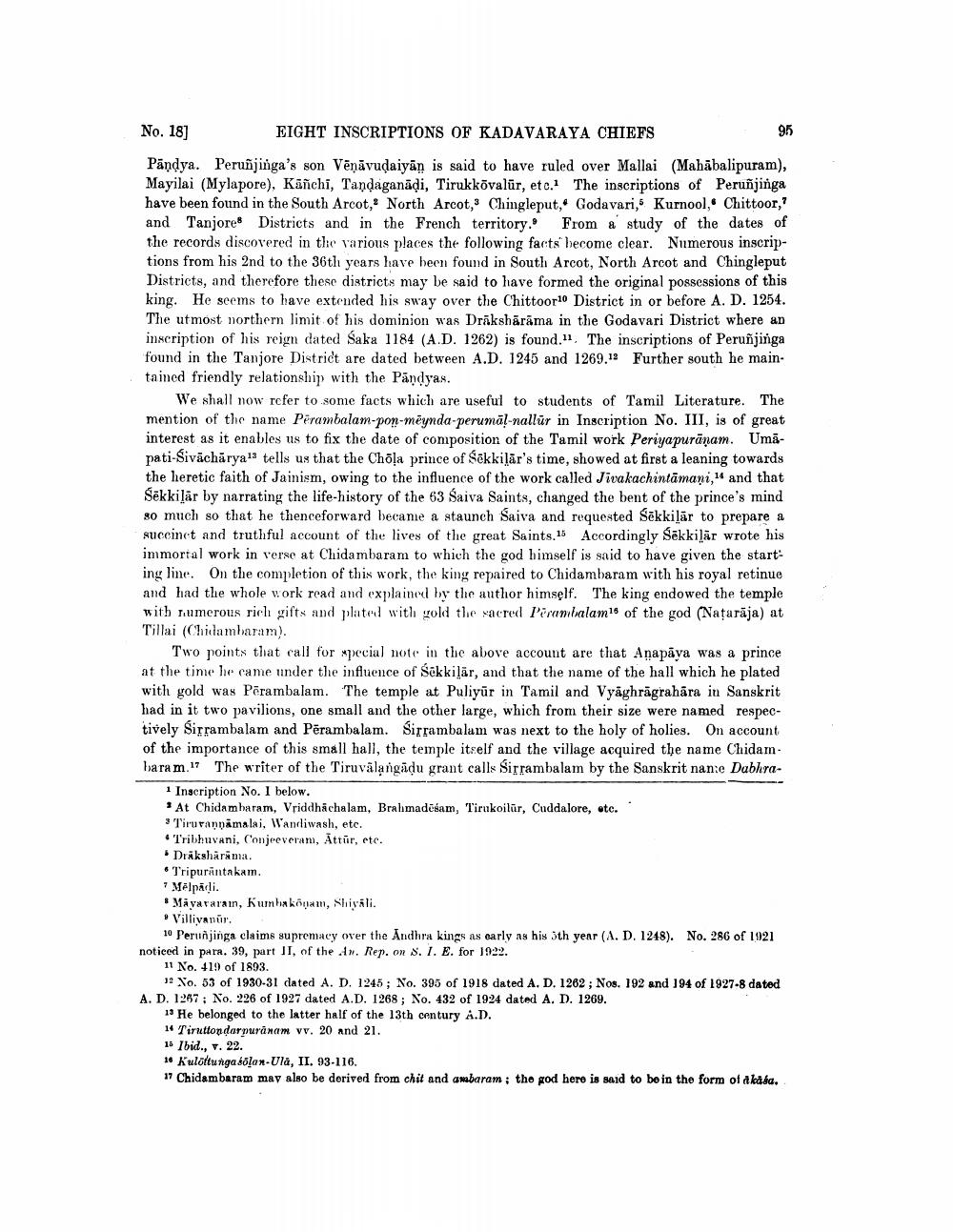________________
No. 18]
EIGHT INSCRIPTIONS OF KADAVARAYA CHIEFS
Pandya. Peruñjinga's son Vēnāvuḍaiyan is said to have ruled over Mallai (Mahabalipuram), Mayilai (Mylapore), Kañchi, Tandaganāḍi, Tirukkõvalur, etc. The inscriptions of Peruñjinga have been found in the South Arcot, North Arcot, Chingleput, Godavari, Kurnool, Chittoor," and Tanjores Districts and in the French territory. From a study of the dates of the records discovered in the various places the following facts become clear. Numerous inscriptions from his 2nd to the 36th years have been found in South Arcot, North Arcot and Chingleput Districts, and therefore these districts may be said to have formed the original possessions of this king. He seems to have extended his sway over the Chittoor10 District in or before A. D. 1254. The utmost northern limit of his dominion was Draksharama in the Godavari District where an inscription of his reign dated Saka 1184 (A.D. 1262) is found.". The inscriptions of Peruñjinga found in the Tanjore District are dated between A.D. 1245 and 1269.12 Further south he maintained friendly relationship with the Pandyas.
We shall now refer to some facts which are useful to students of Tamil Literature. The mention of the name Perambalam-pon-meynda-perumal nallur in Inscription No. III, is of great interest as it enables us to fix the date of composition of the Tamil work Periyapurāṇam. Umāpati-Sivacharya13 tells us that the Chōla prince of Sekkilar's time, showed at first a leaning towards the heretic faith of Jainism, owing to the influence of the work called Jivakachintamani," and that Šēkkilar by narrating the life-history of the 63 Saiva Saints, changed the bent of the prince's mind so much so that he thenceforward became a staunch Saiva and requested Sekkilar to prepare a succinct and truthful account of the lives of the great Saints.15 Accordingly Sekkilär wrote his immortal work in verse at Chidambaram to which the god himself is said to have given the starting line. On the completion of this work, the king repaired to Chidambaram with his royal retinue and had the whole work read and explained by the author himself. The king endowed the temple with numerous rich gifts and plated with gold the sacred Perambalam's of the god (Naṭarāja) at Tillai (Chidambaram).
95
Two points that call for special note in the above account are that Aṇapaya was a prince at the time he came under the influence of Sekkilär, and that the name of the hall which he plated with gold was Perambalam. The temple at Puliyur in Tamil and Vyaghragrahara in Sanskrit had in it two pavilions, one small and the other large, which from their size were named respectively Sirrambalam and Perambalam. Sirrambalam was next to the holy of holies. On account of the importance of this small hall, the temple itself and the village acquired the name Chidambaram." The writer of the Tiruvalangaḍu grant calls Sirrambalam by the Sanskrit nante Dubhra
1 Inscription No. I below.
At Chidambaram, Vriddhachalam, Brahmadesam, Tirukoilur, Cuddalore, etc.
3 Tiruvannamalai, Wandiwash, etc.
Tribhuvani, Conjeeveram, Attur, etc.
* Draksharama.
• Tripurantakam.
7 Melpādi.
Mayavaram, Kumbakonam, Shiyāli.
Villiyanur.
10 Peruñjinga claims supremacy over the Andhra kings as early as his 5th year (A. D. 1248). No. 286 of 1921 noticed in para. 39, part II, of the An. Rep. on S. 1. E. for 1922.
11 No. 419 of 1893.
No. 53 of 1930-31 dated A. D. 1245; No. 395 of 1918 dated A. D. 1262; Nos. 192 and 194 of 1927-8 dated A. D. 1267; No. 226 of 1927 dated A.D. 1268; No. 432 of 1924 dated A. D. 1269.
13 He belonged to the latter half of the 13th century A.D.
14 Tiruttonḍarpuranam vv. 20 and 21.
15 Ibid., v. 22.
16 Kulottungabölan-Ula, II. 93-116.
17 Chidambaram may also be derived from chit and ambaram; the god here is said to be in the form of ākāśa.




